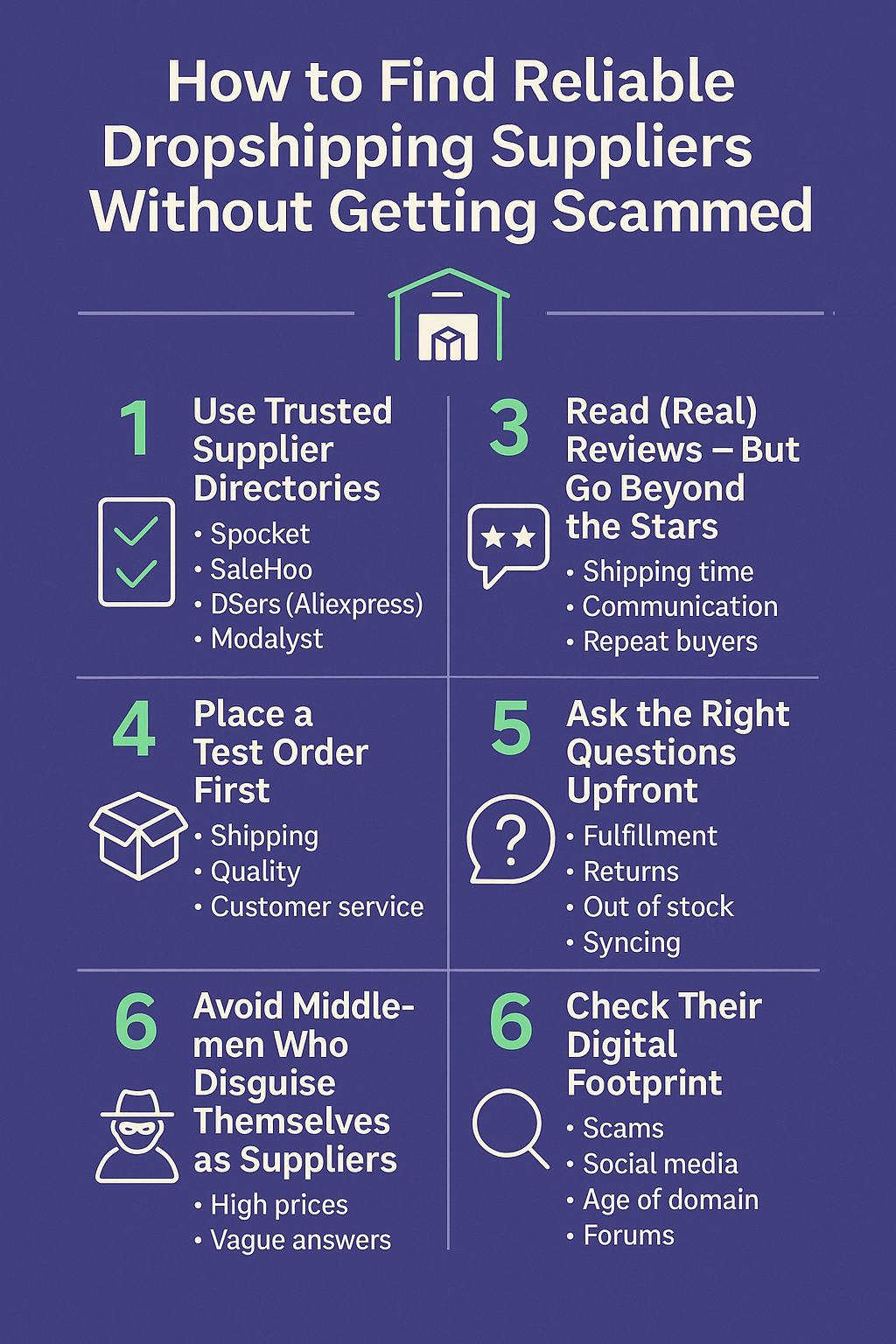The dropshipping model is popular for its low startup cost and flexibility—but it's not without risk. One of the biggest challenges new (and even experienced) sellers face is finding trustworthy suppliers who deliver quality products on time. A bad supplier can destroy your brand reputation, burn your profits, and flood you with angry customers.
So, how do you separate the pros from the pretenders in a sea of online suppliers?
Let’s break it down into a no-fluff guide to finding reliable dropshipping suppliers—without getting scammed.
1. Use Trusted Supplier Directories
Start with platforms that verify and vet suppliers before listing them.
Best directories:
Spocket – Focuses on U.S. and EU-based suppliers.
SaleHoo – Over 8,000 pre-vetted suppliers across multiple niches.
DSers (AliExpress) – Direct integration with Shopify and bulk order tools.
Modalyst – Offers fast shipping from U.S. warehouses.
Worldwide Brands – Lifetime access to certified wholesalers and dropshippers.
????️ Pro Tip: Avoid free, sketchy supplier lists found on forums or YouTube comments. Stick with platforms that offer supplier verification and customer support.
2. Look for Transparent Contact and Business Info
A reliable supplier should be easy to reach and offer clear company details.
What to check:
Business website (not just a marketplace profile)
Verified phone number or support email
Real address (check it on Google Maps!)
LinkedIn or business registry info
If they’re hiding behind vague contact details, that’s a red flag.
3. Read (Real) Reviews—But Go Beyond the Stars
Don’t just skim a 4.8-star rating—dig deeper into what customers are actually saying.
What to look for:
Reviews about shipping times, not just product quality
Mentions of communication and responsiveness
Reviews from repeat buyers or long-term partners
Seller response to complaints
Use tools like AliExpress Seller Rating, Trustpilot, or Facebook groups for extra insights.
4. Place a Test Order First
Would you serve food you’ve never tasted? Same logic applies here.
Before listing a product in your store:
Order it yourself
Track how fast it ships
Inspect the packaging and product quality
Contact customer service with a fake issue and observe the response time
This $20 test could save you from $2,000 in angry refunds later.
5. Ask the Right Questions Upfront
Treat supplier onboarding like hiring a team member. Vet them.
Ask them:
What's your average fulfillment time?
Do you offer tracking numbers and branded packaging?
How do you handle out-of-stock items?
Can I get a CSV or API for product syncing?
Do you support returns and refunds?
A reliable supplier will answer clearly and confidently.
6. Avoid Middlemen Who Disguise Themselves as Suppliers
Some “suppliers” are actually just resellers who buy from real factories and add markups.
Warning signs:
Prices significantly higher than market rate
Vague answers about manufacturing or stock availability
Can't customize packaging or offer volume discounts
Use platforms like Alibaba to reach manufacturers, not middlemen.
7. Check Their Digital Footprint
Scammers leave clues.
Quick checks:
Google their business name + “scam” or “review”
Scan their social media presence (is it active and professional?)
Use WHOIS lookup to see how long their domain has existed
Check online forums (e.g., Reddit, Shopify Community, BlackHatWorld)
A legit supplier usually has some digital history to prove their existence.
Bonus: Look for Suppliers Who Support Branding
High-quality suppliers often allow:
Custom packaging
Branded invoices
White labeling
Bulk order options
If you're serious about building a long-term brand—not just chasing trends—this is crucial.
???? Red Flags = Walk Away
No physical address or business name
Too-good-to-be-true prices
Poor grammar or weird English in communication
Refusal to use secure payment methods (like PayPal or escrow)
Pushy behavior or limited-time threats (“Order now or lose your spot!”)
Final Thoughts
Finding a great dropshipping supplier is half the battle of running a successful eCommerce business. It’s not about luck—it’s about doing your homework. A little extra research today will save you weeks of frustration (and chargebacks) down the road.
✅ Vet.
✅ Test.
✅ Trust... but verify.

